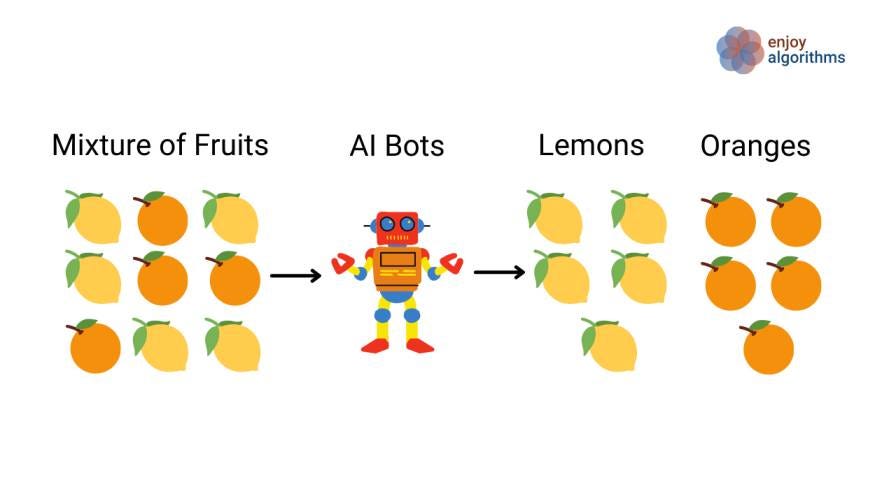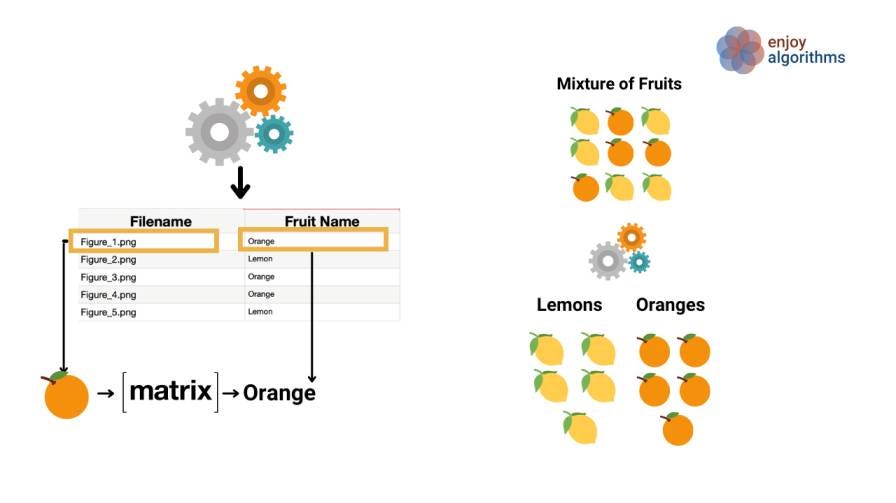Difference between Artificial Intelligence and Machine Learning
Artificial Intelligence (AI) and Machine Learning (ML) are popular terms often used interchangeably in the tech industry. However, it’s important to note that ML is just a subset of AI, meaning an application can belong to Artificial Intelligence but may not belong to Machine Learning. For example, an automatic fan can detect the presence of a person and starts operating is an excellent example of AI, but there is no machine learning here.
This article will discuss the difference between Artificial intelligence and Machine Learning in greater detail. So let’s start with artificial intelligence first.
What is Artificial Intelligence?
Let’s consider separating lemons and oranges into two buckets from a box containing both. Suppose lemons are lighter than oranges.
A human can easily separate the fruits just by looking at them. The question is: Do we always need a human to perform this task? In today’s world, the answer can be no! We can reserve human intelligence for more complex problems and use it for tasks that require higher-level thinking.
The next question is: Can we train our computers to perform this task that requires human intelligence? This is where Artificial Intelligence comes in. It simulates human intelligence to perform tasks that typically require a human’s touch. For example, we can create a robot that uses camera sensors to perceive images of the fruit, determine its weight, and then complete the separation process.
if fruit_weight > 20 gram:
place fruit in Orange bucket
else:
place fruit in Lemon bucketSo, Artificial Intelligence involves creating systems that can perform tasks that require human intelligence, such as visual perception, speech recognition, language translation, etc. In other words, the ultimate goal of AI is to build machines that can exhibit human-like intelligence and capabilities.

Some popular applications of Artificial Intelligence
- Chatbots are computer programs that provide answers to pre-programmed questions. For example, if we chat with Zomato’s chatbot, we can only ask predefined queries, and the chatbot will respond with answers stored on the company’s servers.
- Apple Siri is similar to a chatbot but with a voice assistant. Siri will only be able to provide answers to questions that she has already been programmed to understand and respond to.
- Intelligent humanoid robots are also pre-programmed, performing tasks based on the actions that have been defined for them.
- Online gaming, such as Chess, uses algorithms to make the best decisions based on players' positions in the game.
What is Machine Learning?
Machine Learning is just a subset of AI that focuses on the development of algorithms and statistical models that enable computers to improve their performance on a specific task by developing an understanding from past experiences. It involves training machines using large amounts of historical data, allowing them to identify patterns hidden in the dataset and make predictions or decisions. All these things happen automatically without explicit instructions.
Let’s take the previous example of segregating fruits in the bucket of Lemon and Oranges. Suppose we hire someone for ten days to segregate fruits and record the data from the segregating process. This data will be used to train a machine-learning model.
Here the person is responsible for creating a computer folder containing images of the lemons and oranges and an Excel sheet. The first column in the Excel sheet will be labelled “Filename,” and the second column will be labelled “Fruit Name,” indicating whether the fruit in the corresponding image is a lemon or an orange.
############################################################
File Name | Fruit Name
Figure_1.png | Orange
Figure_2.png | Lemon
Figure_3.png | Orange
Figure_4.png | Orange
Figure_5.png | Lemon After ten days of sorting fruits, enough images and labels indicating whether one is a lemon or an orange will be stored in the folder and Excel sheet. Now hired person is no longer available as the budget does not allow further payment. But separating the fruits into lemon and orange baskets must still be done.
This is where machine learning comes into the picture. This time, we want computers to be even more advanced and closely mimic human intelligence. That is, we want a technique that can look directly at the fruit and predict whether it is a lemon or an orange based on its learning from previous data.

Our computer will use the collected data to identify hidden patterns in this scenario. It analyzes each image, finds a function that would take a new image as input, and determines whether it is a lemon or an orange. This is an example of machine learning, defined as “a science for getting computers to act without being explicitly programmed”.
In other words, machine learning allows computers to learn from existing data and make predictions for future scenarios. So, machine learning is a subset of artificial intelligence that enables the creation of more advanced systems without explicit programming.
Some popular applications of Machine Learning
- Recommendation System: Here, machines learn from the previous behaviours of several customers and recommend products to newer customers. For example, if a person buys a new house, the Machine suggests purchasing new furniture as several other customers bought it together. So, it learned from previous data here. We did not hard-code anything explicitly.
- Twitter Sentiment Analysis: Here, machines learn the sentiment behind the tweet done by the user. Sentiment can be like, by reading the tweet, a machine predicts whether the person is sad or happy. We can not hardcode tweets as sad or happy tweets as the difference of just a single word can change the sentiment of that tweet. There can be millions of ways of showing emotion, and hardcoding every way is impossible. So let the Machine learns from the data directly and learns from it.
- Google Search algorithm: We might have observed that even if we don’t have the exact questions to be searched on Google, it still pops up relevant links. It has seen such users earlier and knows that these are the best-fit queries similar to what we are searching for, as earlier users opened those links and found their solution.
The story behind the separation of Artificial Intelligence and Machine Learning
Although ML is just a subset of AI, ML got discovered earlier than AI. ML came into existence as early as the 1950s. Arthur Samuel first coined the name Machine Learning in 1954 when he observed that machines improved the way it plays board game. Since that, many advancements happened in ML till the 1970s, including perceptrons. Perceptrons failed to learn complex patterns in the dataset, and the development of the ML field became idle for a decade. Data was being recorded with no use. Then in the 1980s, scientists decided to utilize the collected dataset with explicit programming, and a new vertical of AI started.
Is machine learning better than AI?
The question of whether Machine Learning is better than AI is not straightforward, as it depends on the requirement of a specific problem. For example, let’s consider a self-driving car. AI technologies like computer vision and natural language processing must also perceive their surroundings and comprehend human intelligence.
However, to make decisions, such as determining the best route, the car would utilize Machine Learning algorithms that analyze data, such as traffic patterns, road conditions, and previous driving experiences.
Summary of AI vs ML
- AI refers to developing computer systems capable of performing tasks requiring human intelligence. On the other hand, ML is a specific approach to AI that involves teaching a machine to learn from data and improve its performance over time without being explicitly programmed.
- While AI has a broad focus and aims to develop systems that can perform various tasks, ML has a narrow focus and is concerned with training machines to perform specific tasks. ML is one of the components of AI, along with Deep Learning.
Conclusion
In this blog, we have explored the difference between the two most commonly used words in the recent technical industry: Artificial Intelligence and Machine Learning. They both are used interchangeably, but in actuality, ML is just a subset of AI. ML existed before AI, and both technologies have advantages and disadvantages. Please leave your feedback or suggestions if you found this article informative and enjoyable. Enjoy learning, Enjoy algorithms!
